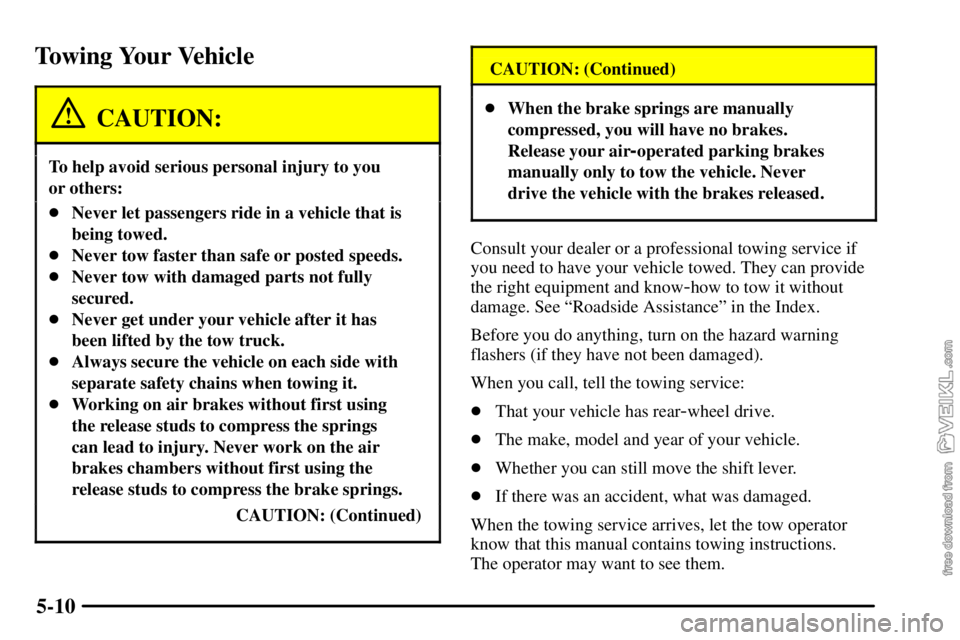Page 235 of 386

5-10
Towing Your Vehicle
CAUTION:
To help avoid serious personal injury to you
or others:
�Never let passengers ride in a vehicle that is
being towed.
�Never tow faster than safe or posted speeds.
�Never tow with damaged parts not fully
secured.
�Never get under your vehicle after it has
been lifted by the tow truck.
�Always secure the vehicle on each side with
separate safety chains when towing it.
�Working on air brakes without first using
the release studs to compress the springs
can lead to injury. Never work on the air
brakes chambers without first using the
release studs to compress the brake springs.
CAUTION: (Continued)
CAUTION: (Continued)
�When the brake springs are manually
compressed, you will have no brakes.
Release your air
-operated parking brakes
manually only to tow the vehicle. Never
drive the vehicle with the brakes released.
Consult your dealer or a professional towing service if
you need to have your vehicle towed. They can provide
the right equipment and know
-how to tow it without
damage. See ªRoadside Assistanceº in the Index.
Before you do anything, turn on the hazard warning
flashers (if they have not been damaged).
When you call, tell the towing service:
�That your vehicle has rear
-wheel drive.
�The make, model and year of your vehicle.
�Whether you can still move the shift lever.
�If there was an accident, what was damaged.
When the towing service arrives, let the tow operator
know that this manual contains towing instructions.
The operator may want to see them.
Page 240 of 386

5-15 Towing Your Vehicle From the Front
(All Wheels On the Ground)
Your vehicle may be towed on all wheels provided the
steering is working. Remember that the power brakes
and power steering will not have power assist. Vehicles
with air brakes will not have brakes. There must be a
tow bar installed between the towing vehicle and the
disabled vehicle.
Before Towing
Block the wheels of the disabled vehicle. On vehicles
with air brakes, release the emergency brake system by
compressing the brake chamber springs as outlined in
this section. (This is to prevent the possibility of the
emergency brake being applied during towing.)
On vehicles with hydraulic brakes, release the parking
brake fully by moving the lever to the fully
-released
position.
Disconnect the propshaft at the rear axle (forward axle
on tandem axle models). Secure the propshaft to the
frame or crossmember.
If there is damage or suspected damage to the axle(s),
remove the axle shafts. Cover the hub openings to
prevent the loss of lubricant or entry of dirt or
foreign objects.After Towing
1. Block the rear wheels and install axle and propshafts.
2. Check for proper phasing of universal joints.
3. Apply the parking brake system before
disconnecting from the towing vehicle.
4. Check and fill with oil as required.
Towing Your Vehicle From the Rear
Before Towing
Secure the steering wheel to maintain a straight
-ahead
position. Make certain that the front axle is not loaded
above the front axle Gross Axle Weight Rating (GAWR)
as indicated on the vehicle's Gross Vehicle Weight
Rating (GVWR) label. See ªGross Vehicle Weight
Rating (GVWR)º in the index for more information.
After Towing
Block the rear wheels and release the steering. Apply the
parking brake system before disconnecting from the
towing vehicle.
Refer to the transmission shift label for additional
information.
Page 385 of 386
8-5
Reporting Safety Defects to the
Canadian Government
If you live in Canada, and you believe that your vehicle
has a safety defect, you should immediately notify
Transport Canada, in addition to notifying General
Motors of Canada Limited. You may write to:
Transport Canada
330 Sparks Street
Tower C
Ottawa, Ontario K1A 0N5
Reporting Safety Defects to
General Motors
In addition to notifying NHTSA (or Transport Canada)
in a situation like this, we certainly hope you'll notify us.
Please call us at 1
-800-TO-CHEVY (1-800-862-4389),
or write:
GM Medium Duty Truck
Customer Assistance Center
P.O. Box 44947
Detroit, MI 48244
In Canada, please call us at 1
-800-263-3777 (English)
or 1
-800-263-7854 (French). Or, write:
General Motors of Canada Limited
Customer Communication Centre, 163-005
1908 Colonel Sam Drive
Oshawa, Ontario L1H 8P7